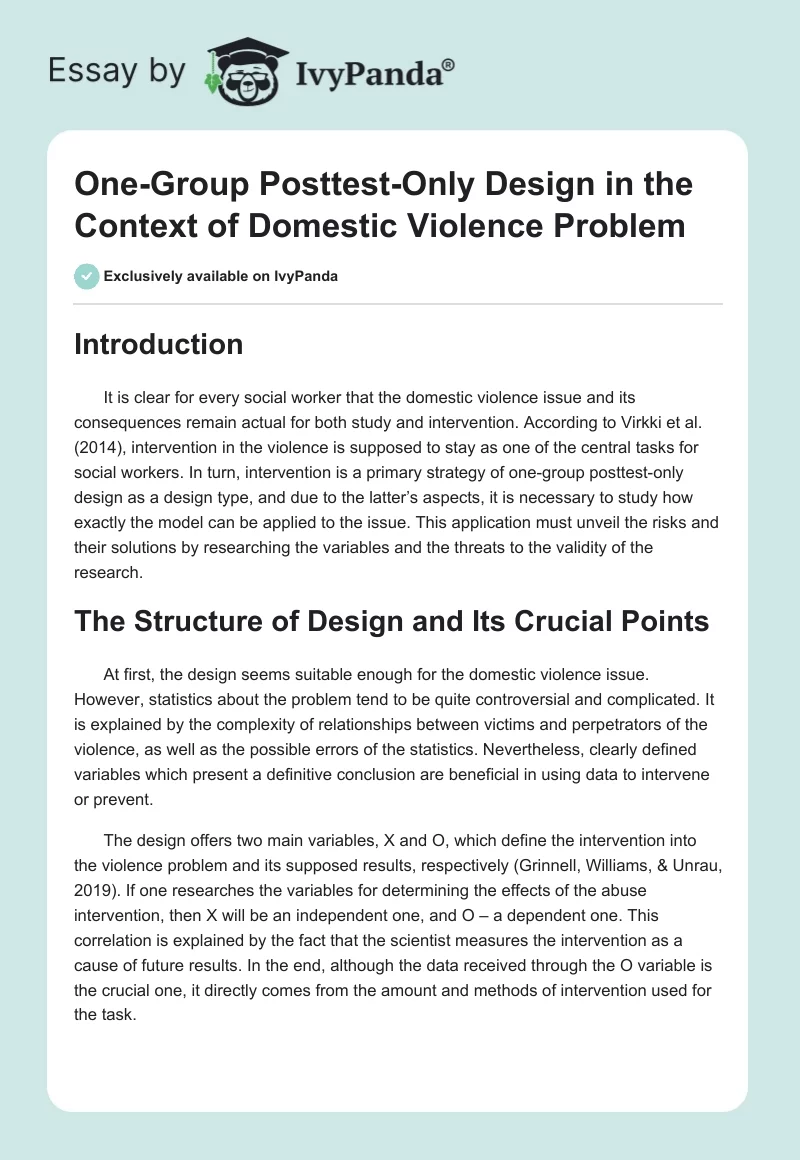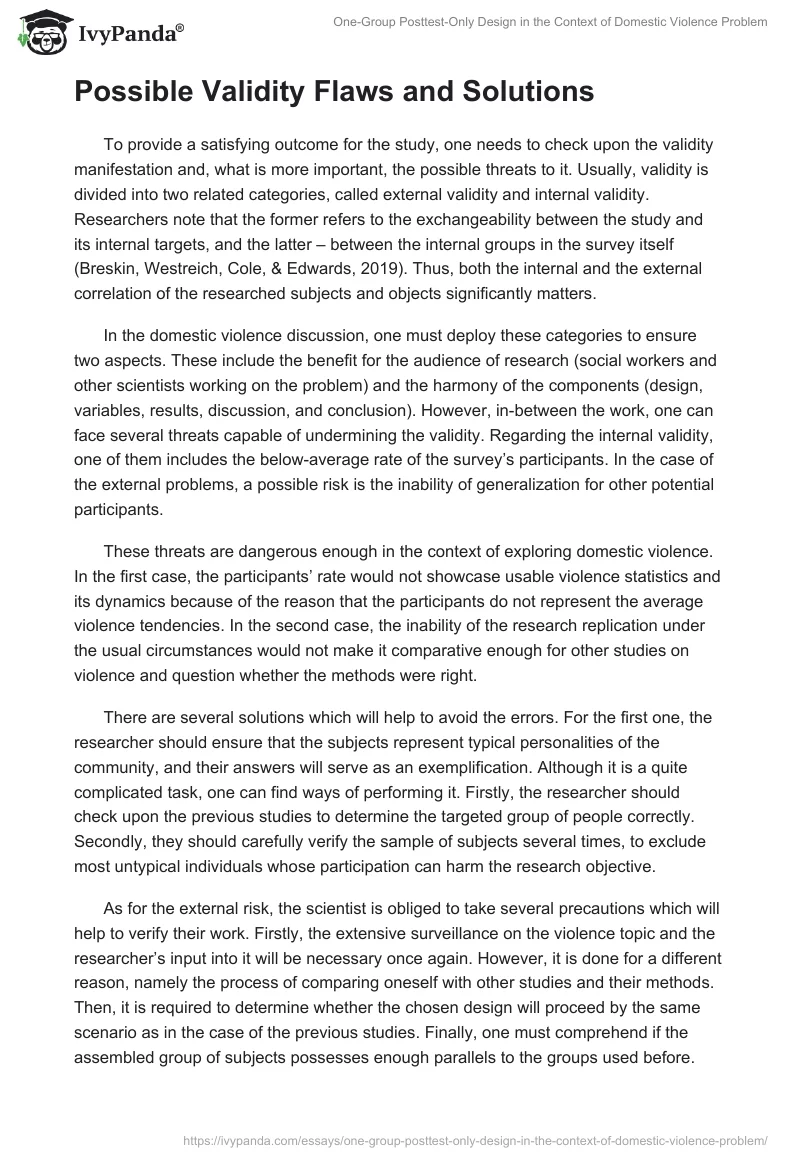Introduction
It is clear for every social worker that the domestic violence issue and its consequences remain actual for both study and intervention. According to Virkki et al. (2014), intervention in the violence is supposed to stay as one of the central tasks for social workers. In turn, intervention is a primary strategy of one-group posttest-only design as a design type, and due to the latter’s aspects, it is necessary to study how exactly the model can be applied to the issue. This application must unveil the risks and their solutions by researching the variables and the threats to the validity of the research.
The Structure of Design and Its Crucial Points
At first, the design seems suitable enough for the domestic violence issue. However, statistics about the problem tend to be quite controversial and complicated. It is explained by the complexity of relationships between victims and perpetrators of the violence, as well as the possible errors of the statistics. Nevertheless, clearly defined variables which present a definitive conclusion are beneficial in using data to intervene or prevent.
The design offers two main variables, X and O, which define the intervention into the violence problem and its supposed results, respectively (Grinnell, Williams, & Unrau, 2019). If one researches the variables for determining the effects of the abuse intervention, then X will be an independent one, and O – a dependent one. This correlation is explained by the fact that the scientist measures the intervention as a cause of future results. In the end, although the data received through the O variable is the crucial one, it directly comes from the amount and methods of intervention used for the task.
Possible Validity Flaws and Solutions
To provide a satisfying outcome for the study, one needs to check upon the validity manifestation and, what is more important, the possible threats to it. Usually, validity is divided into two related categories, called external validity and internal validity. Researchers note that the former refers to the exchangeability between the study and its internal targets, and the latter – between the internal groups in the survey itself (Breskin, Westreich, Cole, & Edwards, 2019). Thus, both the internal and the external correlation of the researched subjects and objects significantly matters.
In the domestic violence discussion, one must deploy these categories to ensure two aspects. These include the benefit for the audience of research (social workers and other scientists working on the problem) and the harmony of the components (design, variables, results, discussion, and conclusion). However, in-between the work, one can face several threats capable of undermining the validity. Regarding the internal validity, one of them includes the below-average rate of the survey’s participants. In the case of the external problems, a possible risk is the inability of generalization for other potential participants.
These threats are dangerous enough in the context of exploring domestic violence. In the first case, the participants’ rate would not showcase usable violence statistics and its dynamics because of the reason that the participants do not represent the average violence tendencies. In the second case, the inability of the research replication under the usual circumstances would not make it comparative enough for other studies on violence and question whether the methods were right.
There are several solutions which will help to avoid the errors. For the first one, the researcher should ensure that the subjects represent typical personalities of the community, and their answers will serve as an exemplification. Although it is a quite complicated task, one can find ways of performing it. Firstly, the researcher should check upon the previous studies to determine the targeted group of people correctly. Secondly, they should carefully verify the sample of subjects several times, to exclude most untypical individuals whose participation can harm the research objective.
As for the external risk, the scientist is obliged to take several precautions which will help to verify their work. Firstly, the extensive surveillance on the violence topic and the researcher’s input into it will be necessary once again. However, it is done for a different reason, namely the process of comparing oneself with other studies and their methods. Then, it is required to determine whether the chosen design will proceed by the same scenario as in the case of the previous studies. Finally, one must comprehend if the assembled group of subjects possesses enough parallels to the groups used before.
Conclusion
To sum up, due to the intervention strategy frequently used in domestic violence research, the one-group posttest-only design is compatible enough with the topic to use it in the research process. Regarding the design structure, the variable of posttest, O, is directly depended on the defining X variable of intervention. However, during the research, one can face several threats to internal and external validity, including unrepresentativeness of the subjects and the inability to replicate the study. It is possible to avoid these errors by attentively checking upon the sample of individuals to choose the typical ones and by deploying the experience of previous studies.
References
Breskin, A., Westreich, D., Cole, S. R., & Edwards, J. K. (2019). Using bounds to compare the strength of exchangeability assumptions for internal and external validity. American Journal of Epidemiology, 188(70), 1355-1360.
Grinnell, R., Williams, M., & Unrau, Y. (2019). Research methods for social workers: An introduction (12th ed.). Michigan, IN: Pair Bond Publications.
Virkki, T., Husso, M., Notko, M., Holma, J., Laitila, A., & Mäntysaari, M. (2014). Possibilities for intervention in domestic violence: Frame analysis of health care professionals’ attitudes. Journal of Social Service Research, 41(1), 6-24.


